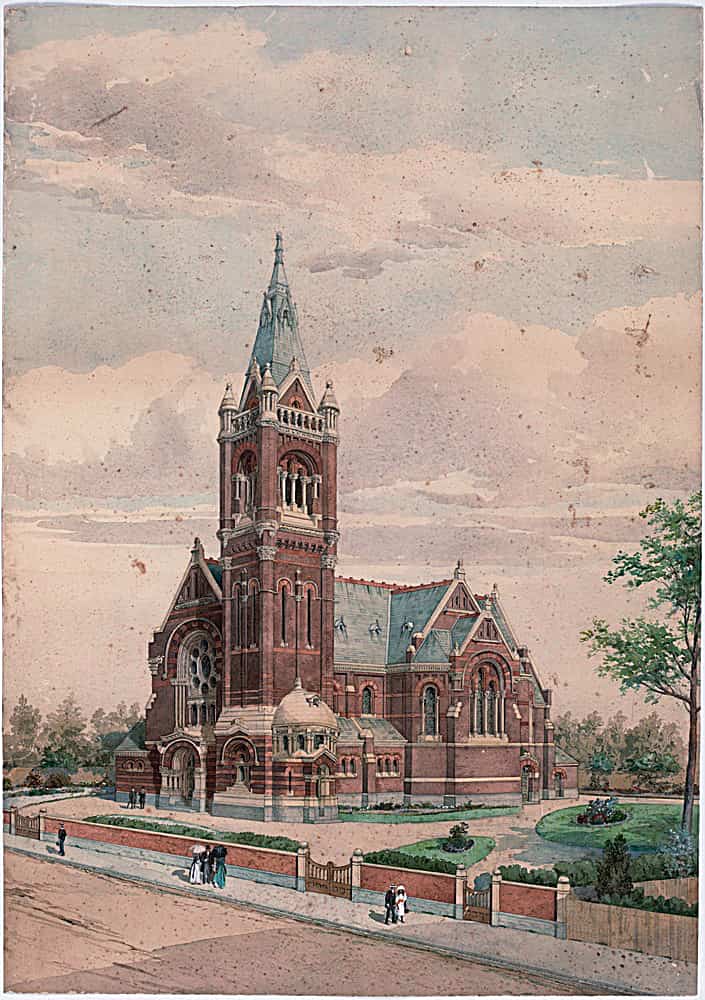
Wesleyan Church, Auburn – Alfred Dunn’s initial design
(photograph of drawing in the church archives [c.1887])
Historical and Technical Documentation by Brian Krahnert and John Maidment
© OHTA, March 2022

Wesleyan Church, Auburn – Alfred Dunn’s initial design
(photograph of drawing in the church archives [c.1887])
Historical and Technical Documentation by Brian Krahnert and John Maidment
© OHTA, March 2022
The first Wesleyan services in the area took place in 1854. A church was later erected at the corner of Burwood Road and William Street. The site was sold, the church demolished and a new property purchased at the corner of Oxley Road and Hepburn Street. The earlier Fincham organ was moved to the Methodist Church, Yann Street, Preston.
The authorities of the Hawthorn Wesleyan Church lately resolved to sell the present site and to erect a complete block of new buildings upon a new site at the corner of Oxley-road and Hepburn-street and they invited competitive designs for a church, Sunday school, parsonage and caretakers cottage. A great number of designs were sent in and after careful examination the trustees have decided to award the first premium to the designs under the motto “Akron” submitted by Mr Alfred Dunn A.V.I.A., 10 Collins-street east, who will prepare the necessary working drawings and specifications for the erection of the buildings which will be commenced as early as possible. The buildings are estimated to cost £13,000.1
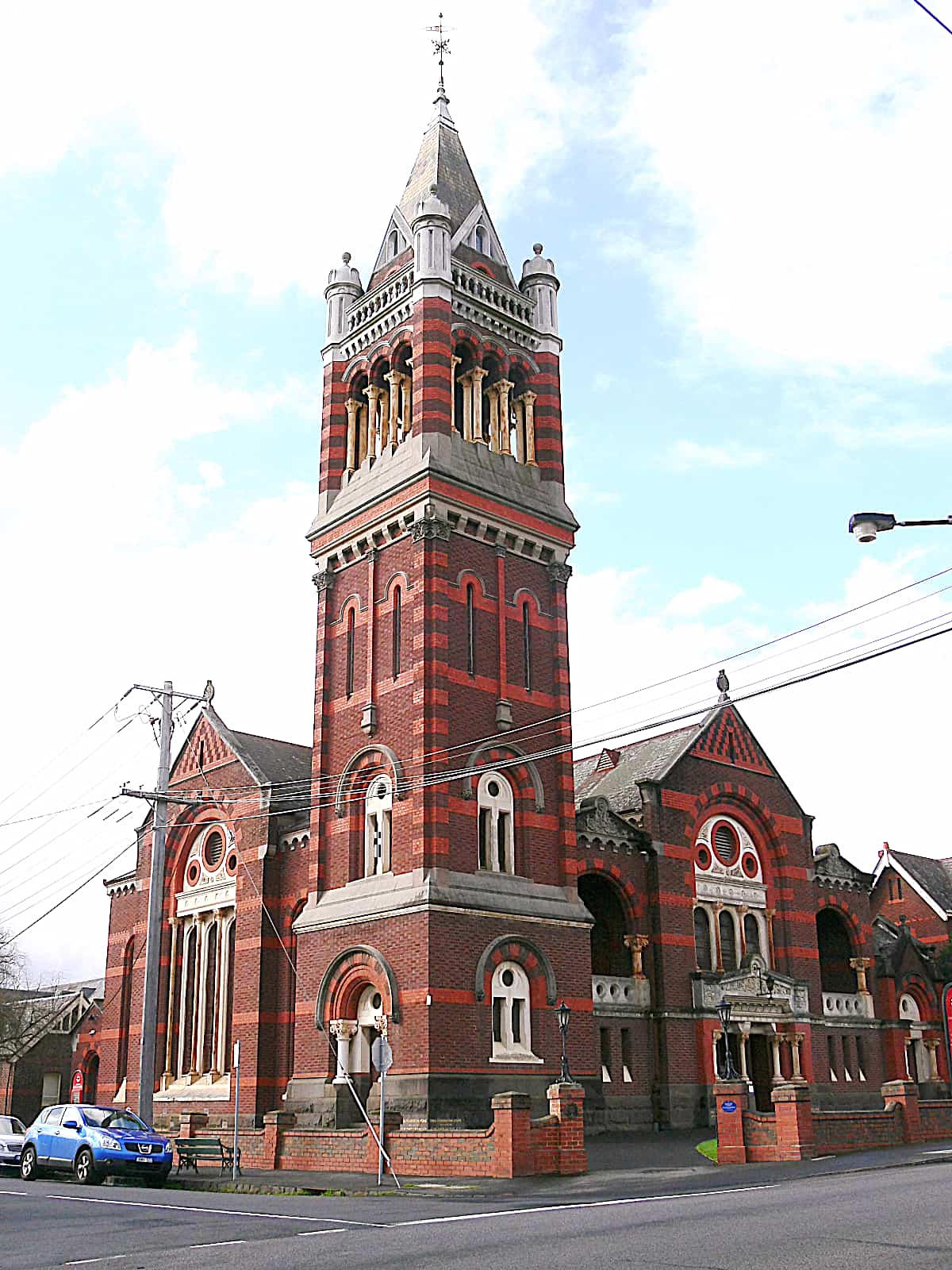
Auburn Uniting Church – exterior from the south-west
(photograph by John Maidment [24 July 2011])
The Victorian Heritage citation for the site reads as follows:
The Trustees advertised in the Argus, inviting 'competitive designs for church, school and parsonage on the new site. The successful design was submitted by talented young Melbourne architect Alfred Dunn, who designed a number of churches for the Wesleyans. Once begun, the entire complex took less than two years to construct and was completed in 1890. Dunn died at the age of 29, only a few years after the Auburn complex was finished.
The complex consists of a main church building, a church hall, parsonage, caretaker's cottage, former stables, and a former infants school. The perimeter brick wall may have replaced an earlier timber picket fence. However, it is the church itself which provided the symbol of the Hawthorn's Circuit's affluence, hailed as one of the finest Wesleyan Methodist churches in Victoria. Constructed on a hill, it became a prominent local landmark.
The main church building is constructed in the Lombardic Romanesque style. The predominant theme is the use of banded, dichromatic brickwork of Hawthorn browns contrasted with deep reds. The dominant element of the church is its multi-levelled tower, which addresses the corner of Oxley Road and Hepburn Street.
The main body of the church is two storeys high with a slate roof and has prominent balconies and gables addressing the streets. The relatively plain interior, with some classical detailing of pilasters with Corinthian capitals, is largely intact. It is arranged as a rectangular auditorium with original pews on a raked floor overlooking the chancel and the visual centrepiece of the church, the 1889 organ designed by Fincham and Hobday.
The parsonage, hall and cottage are architecturally complementary to the church building, similarly employing banded dichromatic brickwork on basalt plinths with slate roofs. The hall is a substantial building with separate entrances for boys and girls, a central stage with radiating classrooms and sliding dividing doors.2
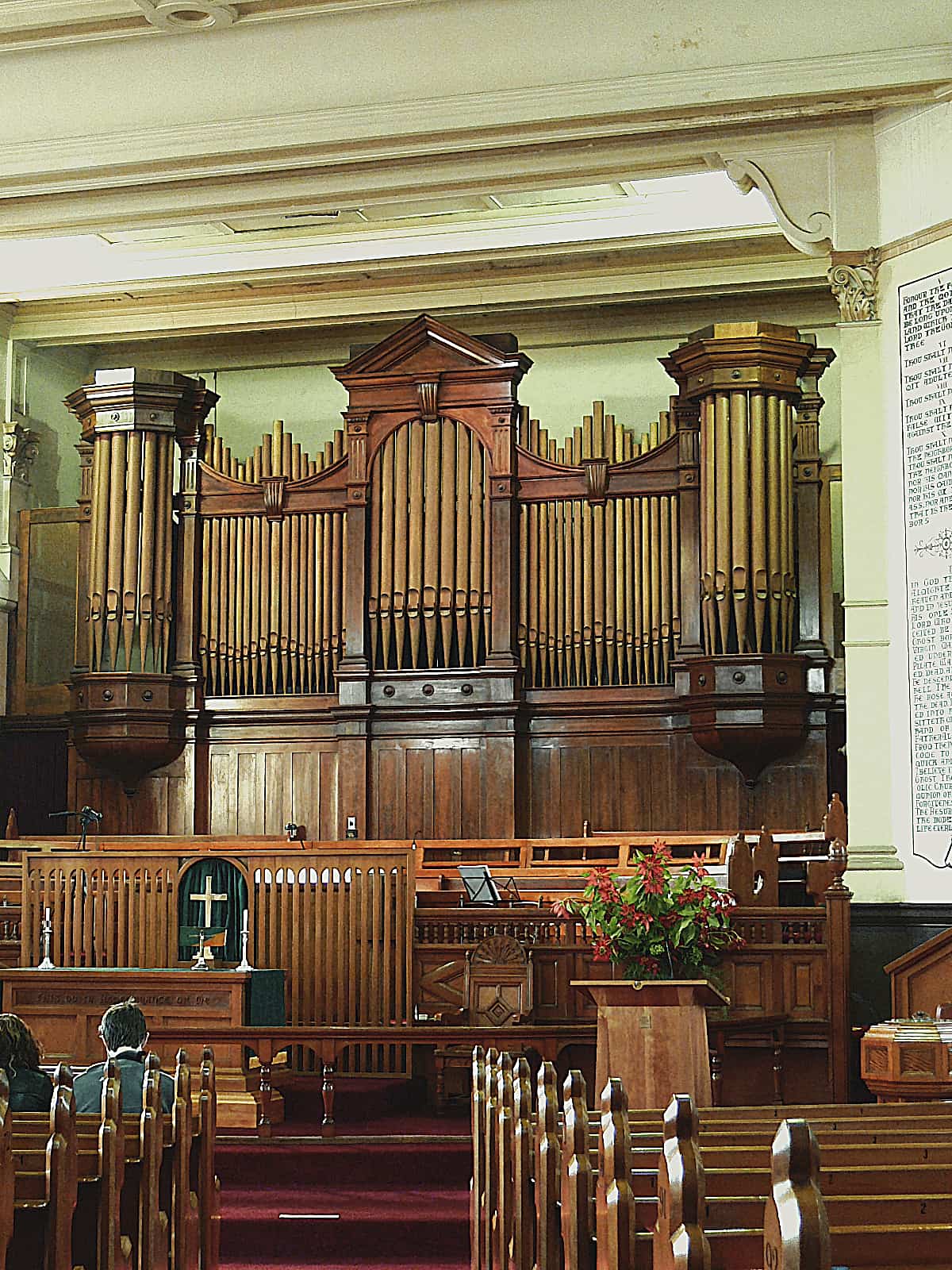
Auburn Uniting Church – the organ case, designed by Alfred Dunn
(photograph by John Maidment [24 July 2011])
The organ was built by Fincham & Hobday and was opened on 2 October 1889. It initially consisted of two manuals, 19 speaking stops, 3 couplers and mechanical action and cost £631. The casework, executed in kauri, was constructed to the design of the architect Alfred Dunn. A design for decorating the façade pipes was submitted by the Sydney artist Augusto Lorenzini (1852-1921), but it is uncertain whether this was implemented.3 In 1892 the organ was enlarged by Fincham & Hobday through the addition of three stops, the action was converted from mechanical to tubular-pneumatic and the console was extended forwards. The organ was reopened on 1 March 1892 and the work cost £300. It is likely that the console incorporated three manual keysets, but the proposed Choir Organ was not installed.4
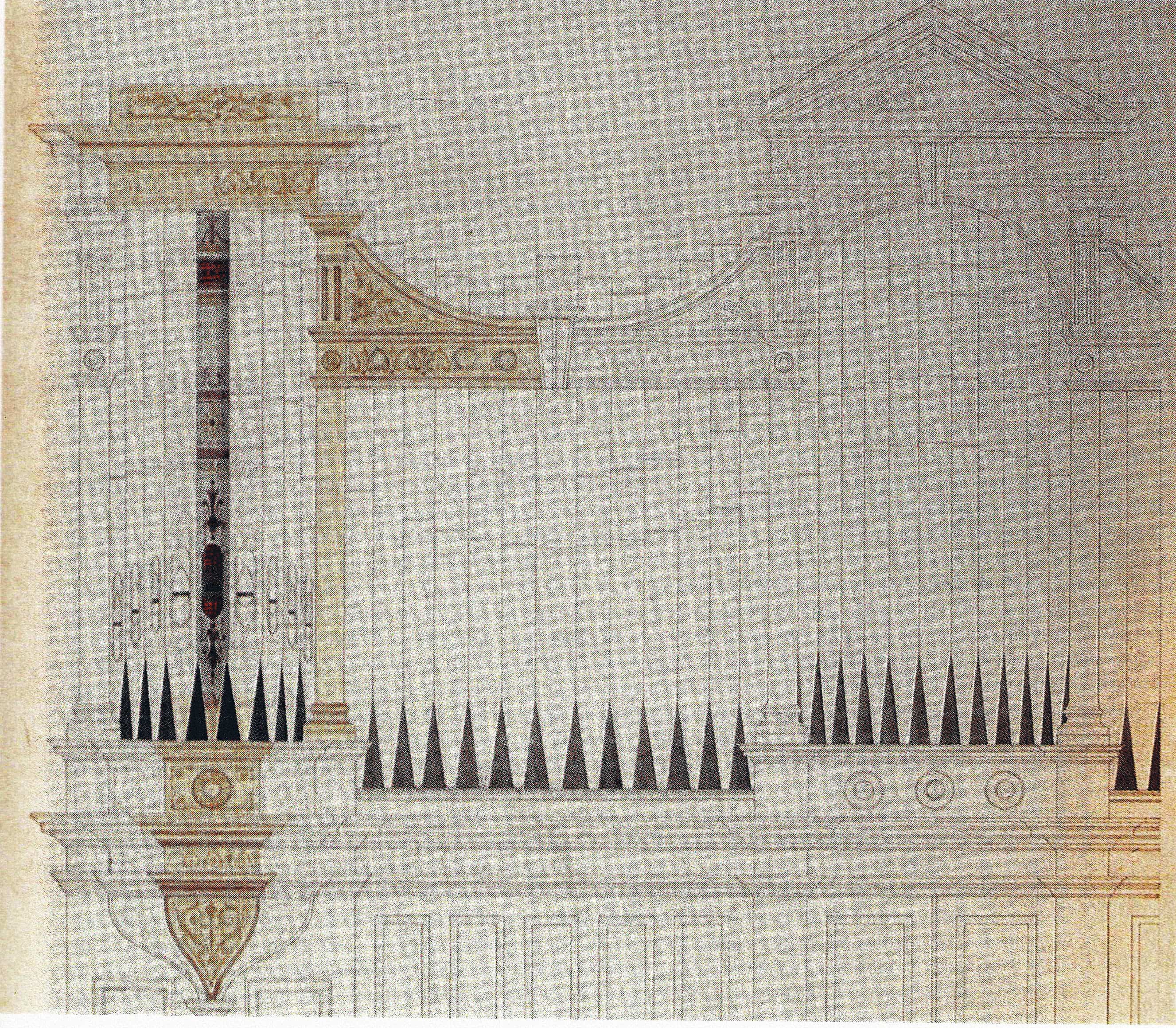
Wesleyan Church, Auburn – design by Augusto Lorenzini for pipe decoration
(Scott Carlin & Megan Martin, Augusto Lorenzini: Italian Artist Decorator in Victorian Sydney
(Glebe: Historic Houses Trust of New South Wales, 2001), p.19)
In 1919, on the recommendation of H.M. Palmer (organ curator at Melbourne Town Hall), quotations were sought from two firms for work on the organ: J.E. Dodd and Meadway & Slatterie. The services of Geo. Fincham & Sons were dispensed with at this time, maybe owing to the fact that Palmer had earlier been sacked by Leslie Fincham. Meadway & Slatterie installed electrical blowing in place of the previous hydraulic engine (still preserved at the church). They also regulated the pneumatic action, added Swell Octave to Great and Swell Sub Octave to Great couplers, cleaned and regulated the pipework and borrowed the bass of the Great Gamba to form a Pedal ‘Cello. A Gedact stop may also have been added to the Great Organ at this time. The work cost £189 and was completed by early 1923.
In 1936 Geo. Fincham & Sons resumed maintenance of the organ and in 1940 the firm overhauled the pneumatic actions, reduced the size of the console and inserted stopkeys, and provided new couplers and combination pistons. A Clarinet was added to the Swell Organ, placed in its own swell box, the whole costing £250. The organ was reopened on 10 November 1940.5 The organ remained in this state until 1967. At some stage the pipe decoration was overpainted in a bronze finish, which has now greatly tarnished.6
| GREAT Bourdon Open Diapason Claribel Gedact Gamba Dulciana Principal Harmonic Flute Twelfth Fifteenth Trumpet Swell to Great Sub Swell to Great Swell to Great Super |
16 8 8 8 8 8 4 4 2-2/3 2 8 |
A |
1922? 1891 |
| SWELL Double Diapason Open Diapason Stopt Diapason Dulciana Vox Angelica Gemshorn Flute Piccolo Mixture 17.19.22 Cornopean Oboe Clarionet Vox Humana Swell Sub Swell Super Tremulant |
16 8 8 8 8 4 4 2 3 rks 8 8 8 8 |
TC TC |
1891 1940 |
| PEDAL Open Diapason Bourdon ‘Cello Great to Pedal Swell to Pedal |
16 16 8 |
A |
1891 1922 |
Compass: 61/30
Tubular-pneumatic action
Balanced swell pedal
Detached stopkey console with third keyboard provided for a Choir Organ
Thumb & toe pistons7
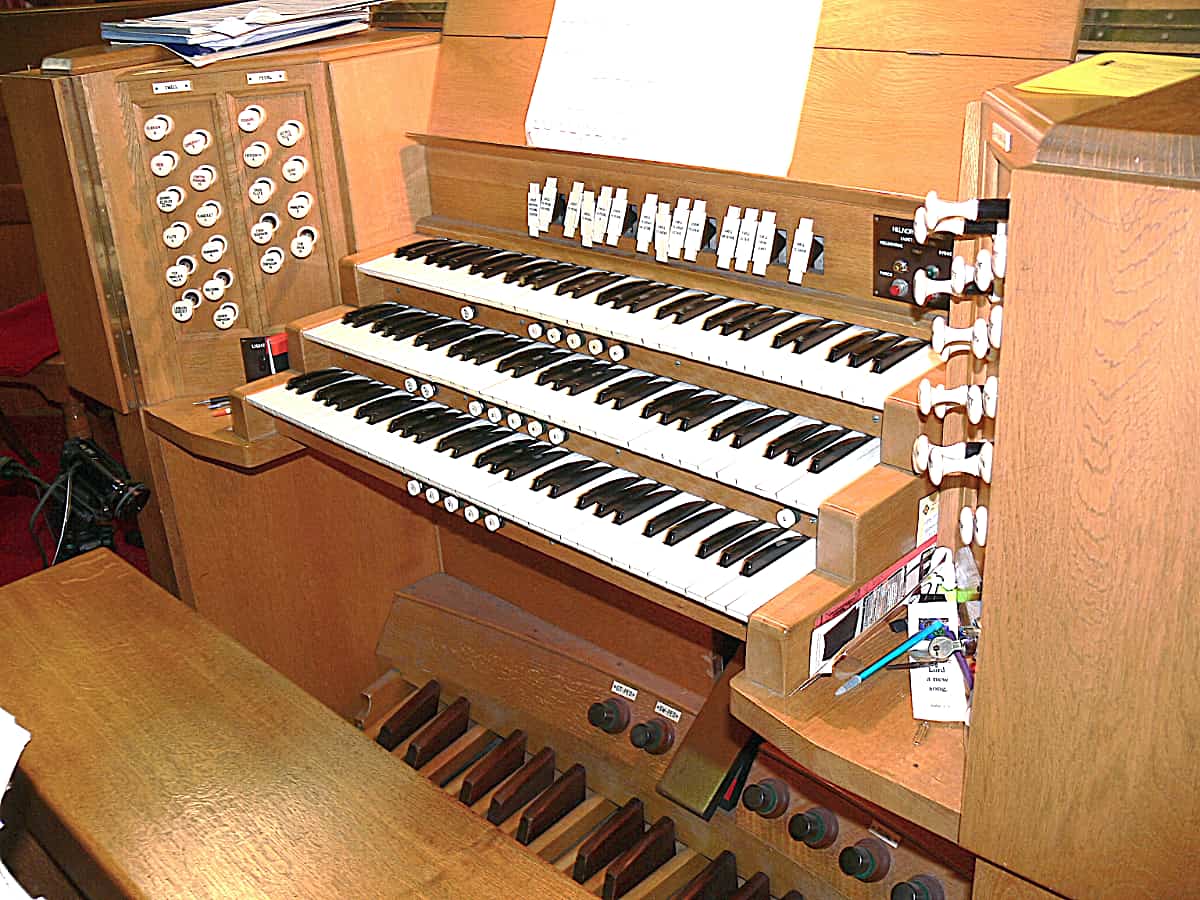
Auburn Uniting Church – the 1967 console
(photograph by John Maidment [24 July 2011])
The organ was extensively rebuilt in 1966-67 by Hill, Norman Beard (Australia) Pty Ltd and the opening recital was given by Lindsay O’Neill on 23 June 1967 before a capacity audience.8
The work consisted of the following:
• Electrification of the former tubular-pneumatic actions;
• Provision of a new detached three-manual drawstop console;
• Provision of an unenclosed Choir organ of two extended ranks placed on electro-magnetic action;
• Enlargement of the Pedal Organ and placement of the former Great Gamba here;
• Provision of a New Scharf 3 ranks for the Swell Organ and separation of the former Swell Mixture and its placement on the Great Organ as a Quartane 2 ranks and a separate Tierce;
• Placement of the Swell Cornopean on a unit chest and its borrowing to 16ft pitch;
• Placement of the former Clarinet on the old discarded Vox Humana slide as a Krummhorn 4ft;
• Revoicing of rebalancing of many ranks.9
Around 1980, John Parker replaced the pipes of the Fincham Swell Cornopean with new pipes imported from Rogers in the UK. In 1987 a new Clarion 4ft stop was made for the Swell, occupying the space of the 1967 Krummhorn. In 1989, the Krummhorn pipes were placed on a separate chest and made available on the Choir Organ as a Clarinet 8ft. Following John Parker’s retirement, the maintenance of the organ was taken over by Australian Pipe Organs Pty Ltd. In 1995, the resonators of the Great Trumpet were repaired and hooded. In 2003, the bottom octave of the Swell Contra Posaune 16ft was added, the whole organ being given a general cleaning and overhaul at this time.10
The current specification of the organ follows:
| GREAT Quintade Open Diapason Claribel Flute Principal Ouverte Flute Twelfth Fifteenth Tierce Quartane 19.22 Trumpet Swell to Great Sub Octave Swell to Great Swell to Great Octave Choir to Great |
16 8 8 4 4 2-2/3 2 1-3/5 2 rks 8 |
former Bourdon revoiced former Harmonic Flute from former Swell Mixture from former Swell Mixture |
|
| SWELL Geigen Diapason Lieblich Gedeckt Dulciana Vox Angelica Gemshorn Flute Flageolet Scharf 22.26.29 Contra Posaune A Cornopean Oboe Clarion Swell Sub Octave Swell Octave Tremulant |
8 8 8 8 4 4 2 3 rks 16 8 8 4 |
TC A A |
|
| CHOIR (unenclosed) Gedeckt Dulciana Nason Flute Dulcet Nazard Block Flute Doublette Larigot Octavin Clarinet Swell to Choir |
8 8 4 4 2-2/3 2 2 1-1/3 1 8 |
B former Swell Double Diapason 16 C former Great Dulciana 8 B C B B C B C |
|
| PEDAL Open Diapason Subbass Echo Bourdon Principal Bass Flute Quint Fifteenth Octave Flute Posaune Great to Pedal Swell to Pedal Swell to Pedal 4ft Choir to Pedal |
16 16 16 8 8 5-1/3 4 4 16 |
D B E former Great Gamba 8 D B E D A |
Great & Pedal pistons coupled
Swell to Pedal pistons
Compass: 61/30
Detached drawstop console
Electro-pneumatic and Electro-magnetic actions
Fixed and adjustable thumb & toe pistons11
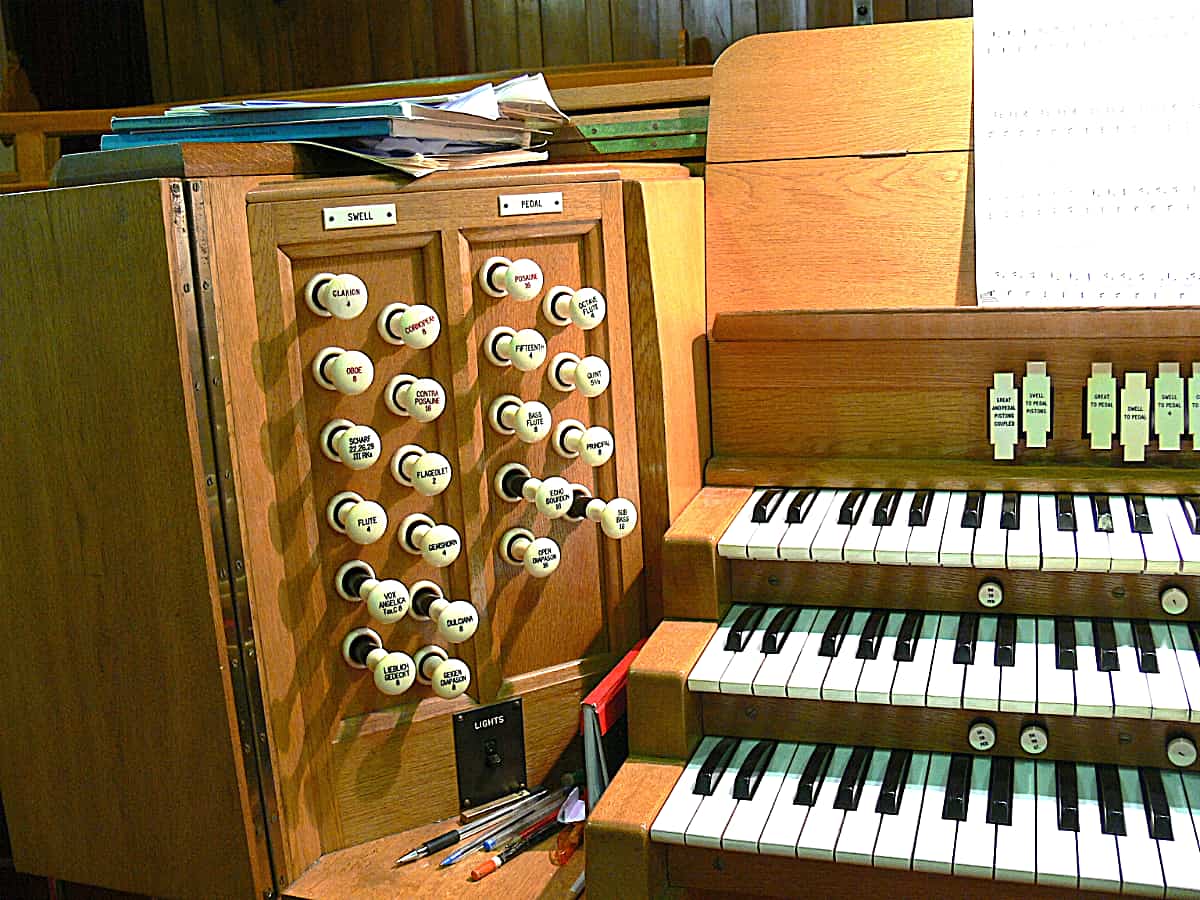
Auburn Uniting Church – left-hand stop jamb, 1967 console
(photograph by John Maidment [24 July 2011])
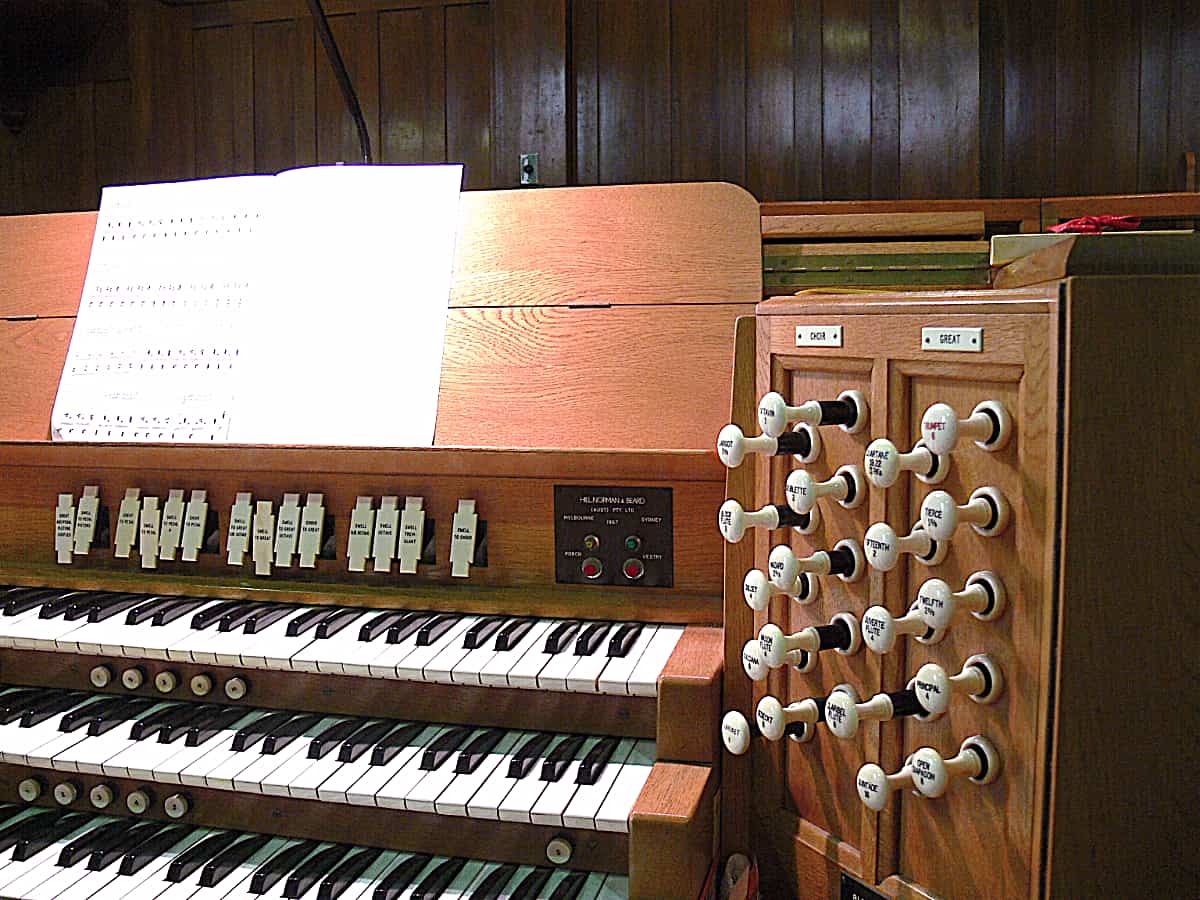
Auburn Uniting Church – right-hand stop jamb, 1967 console
(photograph by John Maidment [24 July 2011])
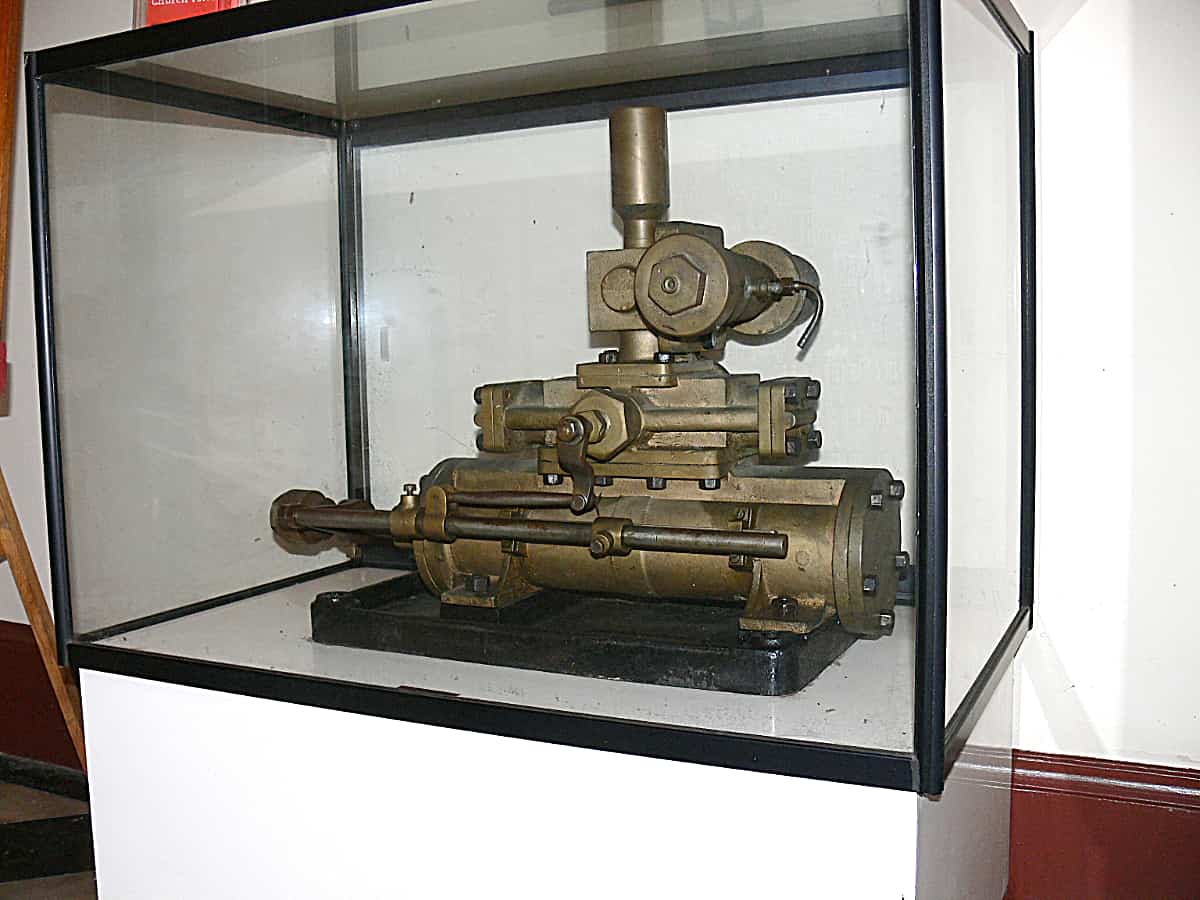
Auburn Uniting Church – hydraulic engine
(photograph by John Maidment [24 July 2011])
1 The Argus, 12 March 1887, p.11
2 Victorian Heritage Register, number H2034
3 https://adb.anu.edu.au/biography/lorenzini-augusto-leopoldo-francesco-13054 for more details on the artist
4 E.N. Matthews, Colonial Organs and Organbuilders (Carlton: Melbourne University Press, 1969), p. 121, information from the Fincham letter books
5 The Age, 11 November 1940, p.13
6 Historical information above from Brian Krahnert’s extensive study: The Evolution of an Organ (privately published, revised edition 2007). Jack Slatterie, who had trained with Hill & Son in London, was a local resident, living in Auburn Grove and is likely to have continued maintaining the organ until 1936.
7 Specification noted by John Maidment 1966
8 Society of Organists (Victoria) Incorporated Newsletter, May 1967, p.4
9 Krahnert, op.cit. and notes by John Maidment 1967
10 Krahnert, op.cit.
11 Specification noted 1967 John Maidment and updated 2022